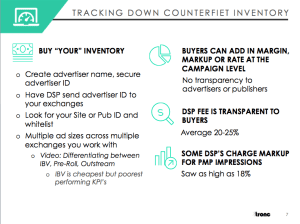
One of the main goals of Ads.txt is to combat domain spoofing. It’s angled to be both simple to understand and implement, and harder for bad actors to game than good old whitelisting and blacklisting. But there’s more to ads.txt than slapping together a list of partners who are authorized to sell your inventory. Before you put that list together, it’s important to do some testing and spot-checking.
Along the lines of testing prior to creating an ads.txt list, Ashley McGee, Director of Programmatic and Platforms at tronc, brought a really cool guide to AdMonsters’ Publisher Forum in Nashville this past November. Her presentation was called “The Spoof Is Up: Battling Counterfeiters With Ads.txt,” and one of top takeaways from her session was: If you want to understand the degree to which ad counterfeiting is a risk to your business, you should think like a buyer, and buy inventory that’s listed as belonging to your sites on the programmatic marketplace.
In short, Ashley explained that a publisher is at risk regardless of whether or not they run programmatic–regardless of whether or not you sell ads on your site, even. Counterfeiters are taking advantage of publishers’ good names–misrepresenting their inventory as yours, while theirs is on fake websites, on spoofed domains, and/or surrounded by garbage content. And whitelisting by site name or URL is not enough to stop these tricks.
So, here’s what publishers should do, as Ashley advised: Partner with a DSP. Look for inventory that’s marked as “yours.” Check to see whether the type of ad units available matches what you know you have on your sites, and that the number of available impressions also matches. Search your URLs and site names, and see if what you find matches what you know to be your URLs and publisher IDs. Then… buy your inventory! Or inventory that purports to be yours, at least. This slide breaks down how that buying process works:
Ashley had a bit of guidance on what to do after the buy, too. When you add up the numbers, factor in the cuts intermediaries take (DSPs, SSPs, exchanges, etc.). Make sure the eCPM of your purchase matches the exchange’s eCPM. Look for any exchanges or ad units that sound fishy to you. And then… get cracking on that ads.txt file!
